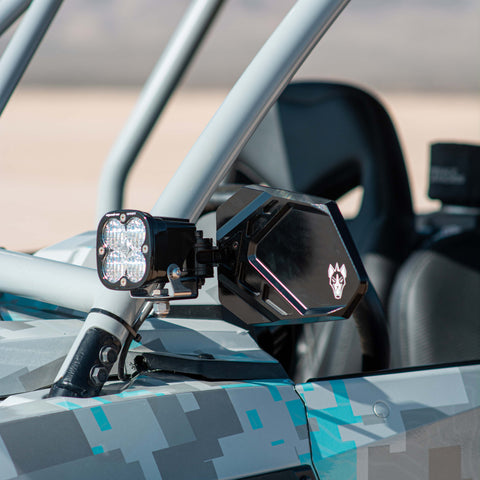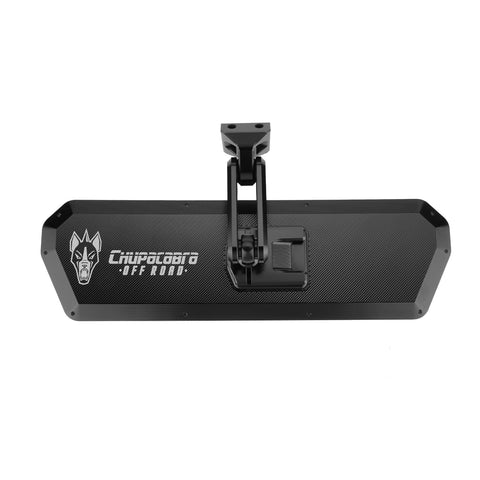Wildcat X

Model: 2014-2021 Wildcat X
Wildcat X Cage Tube Sizes:
- A-Pillar Size (IN): 1.75
- Crossbar Size (IN): 1.75
Product Fitment:
Side Mirrors
Elevate your Arctic Cat Wildcat X with our premium selection of side mirrors, blending cutting-edge functionality with stylish design. The Cuero Race mirror, boasting a robust 1.75" clamp, guarantees unparalleled durability and crystal-clear visibility. Its dual clamp system and adjustable inner mirror ensure optimal sightlines in challenging terrains. Moreover, the integrated light mount bracket enables effortless attachment of Baja Designs Squadron Pro or Sport lights, illuminating your off-road escapades. For those craving enhanced lighting versatility, optional brackets compatible with LP4 and XL80 lights are available, providing superior illumination for your nighttime adventures.
For explorers prioritizing durability and flexibility, the Cuero Pro side mirror with a 1.75" clamp offers the ideal solution. Featuring a breakaway mechanism, this mirror ensures resilience and adaptability on rugged trails. With complete adjustability and a built-in light mount bracket, it facilitates seamless installation of Baja Designs Squadron Pro or Sport lights, guaranteeing optimal visibility during nighttime excursions. Prepare your Arctic Cat Wildcat X for unforgettable off-road journeys with our premium side mirror options.
Cuero Race Mirrors (1.75)
Cuero Race Mirror / Baja Designs Squadron Light Combo

Photo Credit: Michael Spain Smith @michaelspainsmith (IG)
Cuero Race Mirror / Baja Designs LP4 Light Combo
Cuero Race Mirror / Baja Designs XL80 Light Combo
Cuero Pro Mirrors (1.75)

Cuero Pro Mirrors / Baja Designs Squadron Light Combo
Center Mirror
Discover our range of center mirrors, meticulously crafted to elevate your Arctic Cat Wildcat X experience. The Super Deluxe 16" center mirror, now with a sturdy 1.75" clamp, offers an expansive view, with replaceable glass and a convex lens for enhanced visibility. Its dual clamp design ensures stability, while adjustable features guarantee optimal sightlines. Alternatively, our Super Deluxe 11" center mirror, equipped with a 1.75" clamp, boasts a streamlined design and adjustable arm for precise positioning. Find your ideal mirror companion for the Arctic Cat Wildcat X and enhance your off-road excursions.



Cuero Pro Light Combo


Cuero Race Mirror Light Combo


Cuero Race LP4 Light Combo

Cuero Race With XL80 Light Combo

See the reference chart below for more details about fitment of our accessories on your SxS.

Arctic Cat’s Wildcat UTV features a 951cc 8-Valve, 4-Stroke powerplant that is liquid cooled with single overhead cams and 90-degree V-twin cylinders. It was first released in their Thundercat utility ATV back in 2008, and later placed in the Prowler XTZ, making it the first UTV to reach the 1000 plateau. The XTZ was wicked fast! So fast, that we needed an aftermarket roll cage and suspension upgrades before we felt comfortable pushing the throttle to it’s full potential.
This was not the case when we sat in the all-new Wildcat 1000. It sounded ferocious, but with a driver and passenger aboard the new Wildcat 1000, was only reaching speeds in the mid to high 60s. The Wildcat is an acclaimed 10 pounds less than the XTZ, and uses the same Duramatic transmission. What happened to the flame throwing H2 powerplant?
Arctic Cat’s 2013.5 Wildcat X UTV offers a 15% power gain! This was done by improving volumetric efficiency by changing cam profiles to boost its breathing capability. Arctic Cat engineers were able to improved both valve lift and duration, and combined that with a new pistons and a manifold to maximize airflow to the cylinders. This combined with boosted compression ratios made up the bulk of the power gain. The remainder of the HP gains can be attributed to extensive time spent reducing frictional losses and strategic fuel and ignition calibration strategies. As well as increasing HP the engineers also reduced inertia mass in the crankshaft to give the V-twin a huge boost in out of the hole acceleration.
Clutching was improved by tossing out the old design and equipping the Wildcat X with a Team Industries “dry” drive and driven clutch that returned the XTZ 1000s arm stretching torque and horsepower. As you stab the throttle, the front end violently reaches for the sky. When it settles, the new Maxxis Big Horn tires hook up and the Wildcat X blasts down the trail. This time reaching speeds in the mid 70s as we skipped over waist high whoops. The Wildcat X is improved from takeoff all the way though the powerband. The only negative, is that the new X will require the use of 91 octane to support mill upgrades.
This system still features a Spike Load Dampener (SLD) that allows the driveline to slip for a millisecond under harsh spike-loads, reducing the torque load to the system. This allows you to keep your foot on the throttle at all times with out damaging the transmission or destroying axles.
Fuel is fed from a huge 8.8-gallon tank via Arctic Cat’s Electronic Fuel Injection system that utilizes dual 50mm throttle bodies. Throttle response is ridiculous, and cold weather starting and elevation changes were never an issue.
A console-mounted shifter allows for Low, High, Neutral and Reverse ranges. There is also a Park mode, which eliminated the need for an emergency brake. We were able to completely stop halfway up steep up hills, put it in park, and the 1305-pound (dry weight) machine stayed in place.
The Arctic Cat Wildcat’s full-perimeter chassis is constructed from High Strength Low Alloy (HSLA) steel. If you take off the bodywork, the chassis looks more like an off-road truck then a UTV. Arctic Cat is the first to incorporate this type of frame design to UTVs. It’s incredibly strong, lightweight and has a 40/60-front/-rear weight distribution that keeps the front end light and nimble when charging gnarly terrain.
The front of the Wildcat is equipped with a double A-arm setup and 17 inches of wheel travel. At the rear is an industry-first 5-point multi-link trailing arm suspension that offers 18 inches of travel. The Wildcat X’s front and rear suspensions are dampened by new Fox Podium reservoir shocks, which replaced the 2012 Walker Evans setup. These Piggyback reservoir shocks utilized dual rate springs that have 23 position of compression, are preload adjustable and offer 13 inches of ground clearance.
We complained about the Walker Evans setup being too soft on the original Wildcat, which had us bottoming out over squared edges and hard landings. The Fox Podium shocks stiffened up the ride and made it very difficult to bottom. The new rear sway bar also made the Wildcat X more predictable over whoops and in the corners. We believe the Wildcat X to be the best UTV in the rough stuff.
Electronic Power Steering helped in the handling department as well. It’s similar to the Polaris EPS setup, and adjusts for rpm, speed and input for the operator and the wheels.
The power assist is a managed electronic control unit (ECU) that is activated with the turn of the key. It measures steering input force, tire resistance and vehicle speed, and then provides the appropriate assist to the steering column through an electric motor. Even parked on pavement, the wheels would turn much easier. While driving, the steering effort was light and smooth, but you could still feel feedback through the steering wheel. The assist offers more assist at slow speeds. Tight and windy trails could be controlled with one finger. Assist was lowered on high-speed trails, to offer a more comfortable amount of feedback. Even when we bumped into rocks or tagged obstacles close to the trail, the EPS took the hit and it was hardly noticeable through the steering wheel.
replaced them with Maxxis Bighorn treads mounted on cast aluminum 14-inch wheels. The Wildcat X with its explosive power and amazing suspension capabilities needs to offer a beefier tire with more sidewall. The switch to highly capably Bighorn tires was a step in the right direction, but we’d like to see a larger 28-inch tire and beadlocks equipped on the next version of the Wildcat X. This will be our first aftermarket item to be installed on our Project machine.
Bringing the Wildcat X 1000 to a halt are four-wheel hydraulic disc brakes. The brakes were solid but not as good as the RZR XPs, which offer the best stopping power of any SxS we have tested. The Arctic Cat Wild Cat X 1000 does have excellent engine braking, though. This especially helped on downhill descents. Put it in 4wd low and you can coast safely, without braking, down nearly any hill.
Getting in and out of the Wildcat X is quick and easy thanks to a tube-frame door with integrated nets. The doors pivot from the rear and latch at the front via a push button mechanism. However, this mechanism wore out pretty quickly on our 2012, which became aggravating and led us to replacing with a pair of aftermarket doors from Pro Armor.
When you sit in the Wildcat’s cockpit, you feel like you’re part of the machine rather than sitting on top of it. The cockpit also features contoured, high-back bucket seats that rival any aftermarket suspension seat we have tested. There is great back support, and the cut and sewn design cradles around your body. We would have liked to see 5-point seat belt harnesses standard on the Wildcat X, but Arctic Cat opted to use a 3-point seat belt instead. The Arctic Cat Wildcat X is still one of the most comfortable machines available.
Once you sit down, the steering will is infinitely adjustable and allows you to adjust your steering preferences. Controls are laid out so that everything is at your fingertips. 2-wheel to 4-wheel drive is electrically selectable with the same all-in-one 2wd/4wd/Diff Lock rocker switch found on past Arctic Cat UTVs. A center console allows you easy access to the dual plug 12V accessory outlets in the dashboard, and there is a molded tool kit, located underneath the passenger seat. To the right of the steering wheel is Arctic Cat’s new 5-inch digital/analog round gauge. It displays up to 14 critical operations including: clock/hour meter, fuel level, mode but- ton, set/reset button, odometer/trip, gear position, speedometer/tachometer, differential lock, drive select, high beam, battery condition, temperature and oil pressure.
The Arctic Cat Wildcat X also features both front and rear LED lighting that’s clearer than and HID, with two times brighter Lumens than a halogen system that utilizes 50 percent less wattage. This leaves plenty of room on the 36-amp alternator to power a stereo system, radios, cell phone chargers, a GPS and even extra aftermarket lighting accessories.
Storage space on the Wildcat’s is nowhere near the old Prowler XTZ. There is no front storage, but the rear cargo bed has a decent 300-pound capacity. We used it to tote a couple spare tires and fuel during testing. The key locking, passenger side glove box is a convenient storage for tire tools, a couple trail snacks and a 20 oz water bottle. There are also two easy- to-reach cup holders that are located between the driver and passengers feet. We tried for hours to knock our water bottles out of the cup holders with no success.





